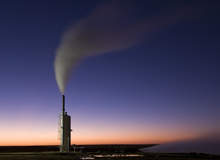
Australia’s mineral wealth is well documented but what is only just emerging is the potential value of its geothermal energy resources. Research is being done across the country to investigate their worth and feasibility, and the positive impact their use could have on the environment.
One piece of recent work has developed a numerical method for estimating the stresses at work on in situ rocks: largely undisturbed rock masses that have remained in place for long periods of time and are usually at considerable depths (more than 3,500m).

Discover B2B Marketing That Performs
Combine business intelligence and editorial excellence to reach engaged professionals across 36 leading media platforms.
Whereas shallow drilling can successfully use conventional methods such as hydraulic fracturing, stress determination in deep drilling is a far tougher prospect.
The method was devised by a team from CSIRO’s Exploration & Mining Division (now part of CSIRO Earth Science and Resource Engineering (CESRE)), led by Dr Baotang Shen, the principal research scientist with the sustainable mining systems team.
“A good understanding of the stress regime within in situ rocks is essential for the efficient extraction of geothermal resources because it is imperative to determine the position and shape of the fracture ‘cloud’ created by hydraulic fracturing in the hot rock,” Dr Shen explained.
“The cloud becomes the geothermal heat exchange reservoir and stresses affect whether the cloud is vertically or horizontally aligned. The ratio of the horizontal stresses to vertical stress is extremely important to the performance of the heat exchange reservoir as it influences the direction of fluid flow.”

US Tariffs are shifting - will you react or anticipate?
Don’t let policy changes catch you off guard. Stay proactive with real-time data and expert analysis.
By GlobalDataA horizontally aligned fracture cloud is preferred because it provides a much better drilling target and extends the reservoir across a narrow temperature interval. The CSIRO team undertook the study in deep granite at Habanero # 1 in South Australia’s Cooper Basin, the first hot-fractured-rock site in Australia, and one owned and operated by Geodynamics Limited.
The goal was to estimate the direction and magnitude of the horizontal stresses using data from the zones of failure in the rock around the borehole (borehole breakout data), including the width, depth and shape of the failures.
The study was conducted using a fracture mechanics numerical code called FRACOD, which simulates the rock fracture initiation and propagation.
Get horizontal
According to Dr Shen, the results indicated that the major and minor principal horizontal stresses are both higher than the vertical stress in the granitic rock at the site. The seismic monitoring results indicated that fractures dipping 10°-20° experienced movement during reservoir stimulation, supporting the model that the vertical stress is the minimum principal stress.
The stimulation involved injecting water at high pressure into the rock formation for two months, a process which opens up existing fractures or creates new ones in the vicinity of the borehole, creating microseismic events and high permeability zones.
“The stress estimate work was done before the stimulation tests, which means the results from the stimulation tests provided a very good validation afterwards,” said Dr Shen.
“This study demonstrates that it is possible to use the borehole breakout data to estimate the magnitude of the principal horizontal stress if a proper numerical model that captures the true rock fracturing process is used.
“The key results showed that when a reservoir develops sub-horizontally (at a low angle <30° from the horizontal direction), there is a high efficiency in thermal exchange and low liquid leakage but when it develops subvertically (at an angle <30° from the vertical direction), the result is low efficiency in thermal exchange and high liquid leakage,” said Dr Shen.
New measure for in situ stress
The team said it was aware of the general trend of the high horizontal stress regime in the Cooper Basin based on previous petroleum drilling but this new numerical model is the first to quantitatively estimate the magnitude of the stresses.
The new method offers the industry an alternative and inexpensive way to study in situ stress. Energy exploration companies can use this data for feasibility studies when preparing to extract a resource but the method can also be applied to any industry which involves deep drilling.
According to chief scientist for Geodynamics Limited, Dr Doone Wyborn, the benefits to industry are significant.
“Geodynamics has been working with CSIRO since 2001 on research topics associated with its hot rock project in northern South Australia,” he said.
“The reservoir rock stress properties are critical to the understanding of the development of the underground heat exchanger, in particular its shape, size and orientation. It is extremely difficult and costly to directly determine the 3D stress field in rocks with high temperatures (250°C) and high fluid over-pressures (75MPa).
“Dr Shen’s model has provided the only reliable alternative method of quantifying the stress conditions. The relative values of the three principal stress axes determined by Dr Shen were verified by the results of the reservoir stimulation process.”
The CSIRO would like to thank Geodynamics Limited for supporting this study and Dr Doone Wyborn for his contributions.
This piece first appeared in CSIRO’s research magazine Earthmatters issue 22 March / April 2010.





